October 3rd, 2008
 The old barn, an outbuilding of the Columbus Zoo, and eventually the Jeffrey summer home in Beechwalde, still stands and was remodeled, on the request of the homeowners, by students at the Interior Design Institute in 1983 for use as a guest house. (Photo courtesy of Terry Miller)
The old barn, an outbuilding of the Columbus Zoo, and eventually the Jeffrey summer home in Beechwalde, still stands and was remodeled, on the request of the homeowners, by students at the Interior Design Institute in 1983 for use as a guest house. (Photo courtesy of Terry Miller)
Tags: Beechwold
Posted in 1900-1940, Houses, Parks & Recreation | No Comments »
October 3rd, 2008
The photos you are seeing here are lovely images of the Beechwold area (west side of High Street) before, or as, the land was being developed into the housing subdivision we know today as “Old Beechwold.” Some of these photos were later used in a promotional brochure–a lovely brochure called “Beechwold the Beautiful,” with a dark green heavy paper cover tied with dark green string with engravings by the Bucher Engraving Co., illustrations and text by Stacy G. Taylor, and printed by the Stoneman Press Company. This same brochure has recently been reprinted by the TWIG organization for use as a fundraiser.
Why the spelling change? Previous owners Joseph Jeffrey had named his country estate “Beechwalde,” and it was changed to “Beechwold” for marketing purposes (=easier to spell) when the land was subdivided and sold for housing units by Charles Johnson.
These photographs were given to me by the granddaughter of Frank Sweigart; Frank worked for Charles F. Johnson for eight years. I am mounting the Beechwold photos in several postings to facilitate some comparisons.
(Images courtesy of Karen Sweigart Longava)

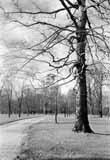

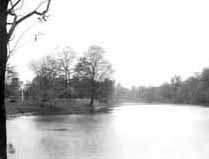
Tags: Beechwold, Charles Johnson
Posted in 1900-1940, Houses, Parks & Recreation | No Comments »
October 3rd, 2008
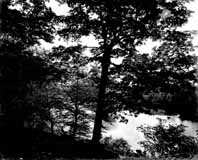

Compare these two images–a photo (albeit reversed) from the collection of Karen Longava Sweigart (granddaughter of Frank Sweigart), and a watercolor print from the promotional brochure from the early days of Old Beechwold. Did the photo inspire the watercolor? (Images courtesy of Karen Sweigart Longava)
Tags: Beechwold, Charles Johnson
Posted in 1900-1940, Houses, Parks & Recreation | No Comments »
October 3rd, 2008
Compare these two images of this wooden structure located somewhere on Beechwold property as the property was being subdivided into a housing development. You can click on the thumbnails to see them in a larger format.
 The first photograph shows tire tracks driving right up to the opening between the two sections of the structure. In that photo there are window panes in the windows, and the structure is surrounded by brush and foliage.
The first photograph shows tire tracks driving right up to the opening between the two sections of the structure. In that photo there are window panes in the windows, and the structure is surrounded by brush and foliage.
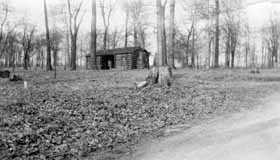 In the second photo, the windows and the foliage are gone. A different photo of the structure during this era is found in my book, Clintonville and Beechwold.
In the second photo, the windows and the foliage are gone. A different photo of the structure during this era is found in my book, Clintonville and Beechwold.
I have been unable to find anyone who remembers the structure first-hand. (The first photo is courtesy of Karen Sweigart Longava; the second photo courtesy of Amy Westervelt.)
Tags: Beechwold, Charles Johnson
Posted in 1800s, 1900-1940, Houses, Parks & Recreation | No Comments »
October 3rd, 2008
Compare this watercolor from the promotional brochure for Beechwold, Beechwold the Beautiful, to the image found in my book, Clintonville and Beechwold, on page 26. (Image courtesy of Karen Sweigart Longava.)
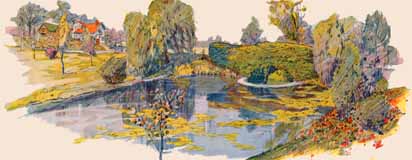
Tags: Beechwold, Charles Johnson
Posted in 1800s, 1900-1940, Houses, Parks & Recreation | 1 Comment »
October 3rd, 2008
 In 1915, there were plans to build a hospital on the corner of Indianola and Olentangy Avenue adjacent to Glen Echo Park. The hospital would cost a quarter of a million dollars and would include several buildings: surgical, medical, maternity, contagious, laboratory, power plant, and nurses’ home. It was to be called Columbus General Hospital and was an outgrowth of Lawrence Hospitals. The goal was to take care of the needs of the rapidly growing north side.
In 1915, there were plans to build a hospital on the corner of Indianola and Olentangy Avenue adjacent to Glen Echo Park. The hospital would cost a quarter of a million dollars and would include several buildings: surgical, medical, maternity, contagious, laboratory, power plant, and nurses’ home. It was to be called Columbus General Hospital and was an outgrowth of Lawrence Hospitals. The goal was to take care of the needs of the rapidly growing north side.
Tags: North Columbus
Posted in 1900-1940 | 2 Comments »
October 3rd, 2008
This 1903 topographic map shows the road configuration of the intersection of East North Broadway and High Streets. To orient yourself, remember that there were no bridges across the Olentangy River between Dodridge and Henderson, so Dodridge is the southern bridge and Henderson next bridge north of that. Calumet Street did not exist, and many other side streets had as yet to be developed, or were called by different names than they are today.
Tags: Maps, N. Broadway
Posted in 1900-1940, Transportation | No Comments »
October 3rd, 2008
The Worthington Pike, now called High Street, was supported by funds collected from a toll gate which was located opposite from Olentangy Park. The gate was operated by the Applican family, parents of Mrs. N. E. McCoy. The pole was let down each night and not opened until 4:00 a.m. Dr. Albert Cooper was the North Columbus physician at that time. If he had gone north on a call. the toll keeper always waited up for him or else was roused from his sleep in the night to raise the pole and let the doctor pass through on his homeward trip. –from an old undated newspaper clipping
Posted in 1800s, 1900-1940, Transportation | No Comments »
October 3rd, 2008
One of my favorite maps is this one from Baist’s Atlas, produced around 1920. Someone sent it to me while I was working on my book. Note that North High School had not yet been built on Arcadia.
Tags: Maps
Posted in 1900-1940 | No Comments »
October 3rd, 2008
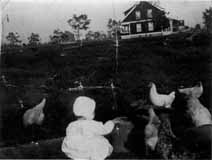
“The Dominion Land Company has purchased the Whipp and Ingham farm containing 90 acres of land, Stop 15 C.D. & M. on North High Street. The ground was purchased by the company to supply numerous customers with large lots where the soil is rich. It is to be platted into extremely large lots and will be sold on easy terms so as to enable a great number of people to follow their regular work in the City and at the same time, have lands where they can have a nice garden and keep a few chickens and thus help the problem of the high cost of living…The name of this sub-division will be Highland Gardens.” –from The Dominion Land Company Columbus Home News, May 1913, Volume 1 Number 2.
(This photo is Louise Corp on Tulane Road, but I’m sure the chickens of Highland Gardens looked much the same. Photo courtesy of the Clintonville Historical Society.)
Tags: Charles Johnson, Clintonville Historical Society collection, Whip family
Posted in 1900-1940, Houses, People | No Comments »
 The old barn, an outbuilding of the Columbus Zoo, and eventually the Jeffrey summer home in Beechwalde, still stands and was remodeled, on the request of the homeowners, by students at the Interior Design Institute in 1983 for use as a guest house. (Photo courtesy of Terry Miller)
The old barn, an outbuilding of the Columbus Zoo, and eventually the Jeffrey summer home in Beechwalde, still stands and was remodeled, on the request of the homeowners, by students at the Interior Design Institute in 1983 for use as a guest house. (Photo courtesy of Terry Miller)








 In 1915, there were plans to build a hospital on the corner of Indianola and Olentangy Avenue adjacent to Glen Echo Park. The hospital would cost a quarter of a million dollars and would include several buildings: surgical, medical, maternity, contagious, laboratory, power plant, and nurses’ home. It was to be called Columbus General Hospital and was an outgrowth of Lawrence Hospitals. The goal was to take care of the needs of the rapidly growing north side.
In 1915, there were plans to build a hospital on the corner of Indianola and Olentangy Avenue adjacent to Glen Echo Park. The hospital would cost a quarter of a million dollars and would include several buildings: surgical, medical, maternity, contagious, laboratory, power plant, and nurses’ home. It was to be called Columbus General Hospital and was an outgrowth of Lawrence Hospitals. The goal was to take care of the needs of the rapidly growing north side.
